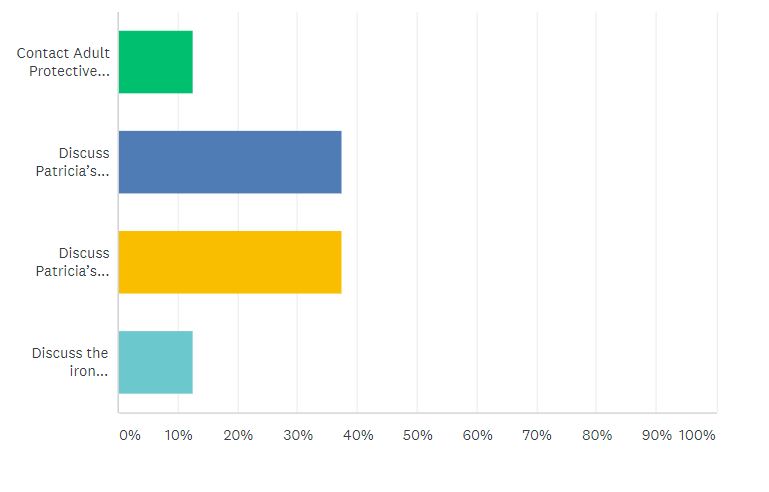May Question
Last month, we read about the case of Patricia, an elderly woman with a complicated medical history. Let’s review:
On your internal medicine rotation, you are rounding on Patricia, an 86-year-old woman who lives with her daughter. Your patient has dementia and her daughter manages her finances, medications, and important medical decisions. Patricia is very thin and has been evaluated in the past for malnutrition. She tells you she sometimes eats just once per day. Her most recent labs show a hemoglobin of 7.3 and an MCV of 73, indicating a significant microcytic anemia. Her daughter tells you that Patricia has been prescribed iron supplements in the past, and that she gives them to her mother daily. Later, she tells the intern on the team that her mother’s only medication is for her blood pressure and does not mention the iron. When questioned, Patricia’s daughter says she does not give her mother iron supplements. During the conversation, the patient’s daughter tells the intern that she never finished high school and that she doesn’t understand all of her mother’s medical problems. You and the intern discuss your concern that the patient’s daughter may not be equipped to handle her mother’s medical care. As you review the chart with the team, you see that the patient has had several visits in the past 3 years, with similar lab results indicating microcytic anemia and multiple iron panels indicating very low iron levels. In each visit, there is substantial documentation of counseling and education for the patient’s daughter. You and the team discuss the plan for Patricia and her daughter’s ability to care for her. What should you do next?
- Contact Adult Protective Services immediately. This is elder neglect and Patricia should be removed from the home.
- Discuss Patricia’s medical problems with her daughter. Educate her on the importance of iron supplements and proper nutrition. Schedule a follow up appointment for Patricia in two months for new bloodwork and iron studies.
- Discuss Patricia’s medical problems with her and her daughter. Suggest that Patricia be moved to a dedicated care facility where medical professionals will manage her daily medications and meals, and ensure that her iron deficiency is resolved.
- Discuss the iron deficiency, anemia, and malnutrition with Patricia. Allow her to make her own decisions regarding her care and living situation.

Last month’s question appeared to be more divisive among readers. Answer choice one was chosen by 12.5% of respondents; Answer choice two was chosen by 37.5% of respondents; Answer choice three was chosen by 37.5% of respondents and answer choice four was chosen by 12.5% of respondents. The most popular choices were to educate Patricia’s daughter and schedule a follow up or to suggest Patricia move to a dedicated care home.
July Question
Joseph, an exceptionally bright and articulate 13 year old, is found to have a rapidly growing osteosarcoma in his right femur. Surgery is required and it is likely that a blood transfusion will be required during the operation. As Jehovah’s Witness practitioners, Joseph’s parents state that they are unwilling to give their consent to any procedure which involves giving him blood products. Initially, Joseph agrees with them, even though you thoroughly explain the risks of refusing treatment. However, later on, when you and your colleagues are alone with Joseph, he tells you that he is scared and would like you to do whatever you think is best. What do you do next?
Tell us what you think!
Bridget Ralston is a member of The University of Arizona College of Medicine – Phoenix Class of 2020. She graduated from Santa Clara University in 2015 with a Bachelor of Science in Chemistry and a French minor. She de-stresses by whipping up delicious treats (and subsequently devouring them), playing soccer, and cuddling with her cat, Tuxedo. She has a particular interest in healthcare for underserved communities.

